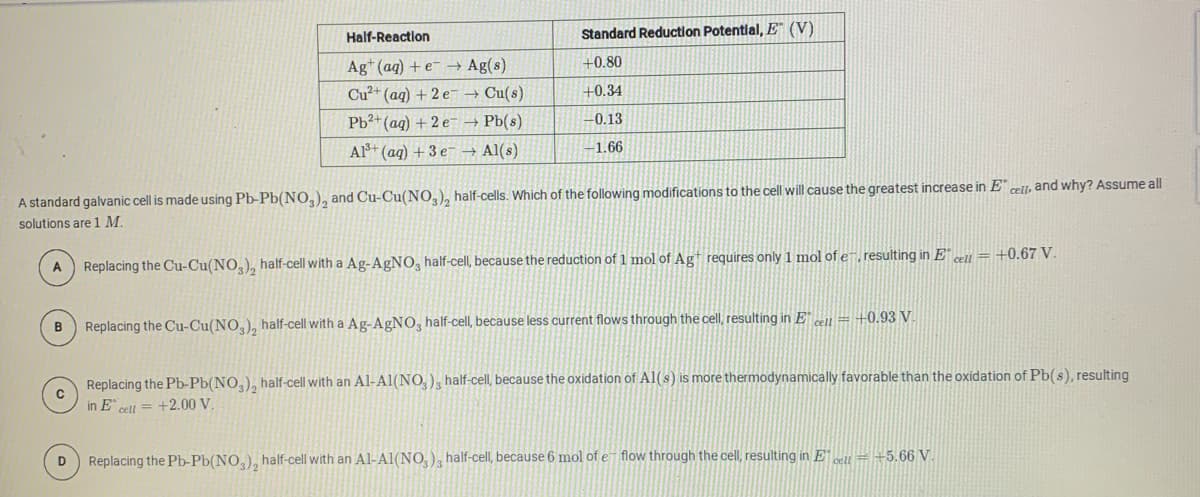Half-Reaction Standard Reduction Potential, E (V) Ag* (aq) +e- -→ Ag(s) +0.80 Cu?+ (aq) + 2 e- → Cu(s) +0.34 Pb²+(ag) + 2 e- → Pb(s) -0.13 A+ (ag) + 3 e- → Al(s) -1,66 A standard galvanic cell is made using Pb-Pb(NO,), and Cu-Cu(NO,), half-cells. Which of the following modifications to the cell will cause the greatest increase in E" cell, and why? Assume all solutions are1 M. cell = +0.67 V A Replacing the Cu-Cu(NO,), half-cell with a Ag-AGNO, half-cell, because the reduction of 1 mol of Agt requires only 1 mol of e, resulting in E'. B Replacing the Cu-Cu(NO,), half-cell with a Ag-AGNO, half-cell, because less current flows through the cell, resulting in E = +0.93 V. Replacing the Pb-Pb(NO,), half-cell with an Al-Al(NO,), half-cell, because the oxidation of A1(s) is more thermodynamically favorable than the oxidation of Pb(s), resulting in E cell = +2.00 V. D Replacing the Pb-Pb(NO,), half-cell with an Al-Al(NO,), half-cell, because 6 mol of e flow through the cell, resulting in Ei= +5.66 V.
Half-Reaction Standard Reduction Potential, E (V) Ag* (aq) +e- -→ Ag(s) +0.80 Cu?+ (aq) + 2 e- → Cu(s) +0.34 Pb²+(ag) + 2 e- → Pb(s) -0.13 A+ (ag) + 3 e- → Al(s) -1,66 A standard galvanic cell is made using Pb-Pb(NO,), and Cu-Cu(NO,), half-cells. Which of the following modifications to the cell will cause the greatest increase in E" cell, and why? Assume all solutions are1 M. cell = +0.67 V A Replacing the Cu-Cu(NO,), half-cell with a Ag-AGNO, half-cell, because the reduction of 1 mol of Agt requires only 1 mol of e, resulting in E'. B Replacing the Cu-Cu(NO,), half-cell with a Ag-AGNO, half-cell, because less current flows through the cell, resulting in E = +0.93 V. Replacing the Pb-Pb(NO,), half-cell with an Al-Al(NO,), half-cell, because the oxidation of A1(s) is more thermodynamically favorable than the oxidation of Pb(s), resulting in E cell = +2.00 V. D Replacing the Pb-Pb(NO,), half-cell with an Al-Al(NO,), half-cell, because 6 mol of e flow through the cell, resulting in Ei= +5.66 V.
Chemistry: An Atoms First Approach
2nd Edition
ISBN:9781305079243
Author:Steven S. Zumdahl, Susan A. Zumdahl
Publisher:Steven S. Zumdahl, Susan A. Zumdahl
Chapter17: Electrochemistry
Section: Chapter Questions
Problem 135CWP: Consider a galvanic cell based on the following half-reactions: a. What is the expected cell...
Related questions
Question

Transcribed Image Text:Half-Reaction
Standard Reduction Potential, E (V)
Ag* (aq) +e- -→ Ag(s)
+0.80
Cu?+ (aq) + 2 e- → Cu(s)
+0.34
Pb²+(ag) + 2 e- → Pb(s)
-0.13
A+ (ag) + 3 e- → Al(s)
-1,66
A standard galvanic cell is made using Pb-Pb(NO,), and Cu-Cu(NO,), half-cells. Which of the following modifications to the cell will cause the greatest increase in E" cell, and why? Assume all
solutions are 1 M.
cell = +0.67 V
A
Replacing the Cu-Cu(NO,), half-cell with a Ag-AGNO, half-cell, because the reduction of 1 mol of Agt requires only 1 mol of e, resulting in E' .
B
Replacing the Cu-Cu(NO,), half-cell with a Ag-AGNO, half-cell, because less current flows through the cell, resulting in E = +0.93 V.
Replacing the Pb-Pb(NO,), half-cell with an Al-Al(NO,), half-cell, because the oxidation of A1(s) is more thermodynamically favorable than the oxidation of Pb(s), resulting
in E cell = +2.00 V.
Replacing the Pb-Pb(NO,), half-cell with an Al-Al(NO,), half-cell, because 6 mol of e flow through the cell, resulting in E = +5.66 V.
Expert Solution
This question has been solved!
Explore an expertly crafted, step-by-step solution for a thorough understanding of key concepts.
This is a popular solution!
Trending now
This is a popular solution!
Step by step
Solved in 3 steps with 1 images

Knowledge Booster
Learn more about
Need a deep-dive on the concept behind this application? Look no further. Learn more about this topic, chemistry and related others by exploring similar questions and additional content below.Recommended textbooks for you

Chemistry: An Atoms First Approach
Chemistry
ISBN:
9781305079243
Author:
Steven S. Zumdahl, Susan A. Zumdahl
Publisher:
Cengage Learning

Chemistry
Chemistry
ISBN:
9781305957404
Author:
Steven S. Zumdahl, Susan A. Zumdahl, Donald J. DeCoste
Publisher:
Cengage Learning


Chemistry: An Atoms First Approach
Chemistry
ISBN:
9781305079243
Author:
Steven S. Zumdahl, Susan A. Zumdahl
Publisher:
Cengage Learning

Chemistry
Chemistry
ISBN:
9781305957404
Author:
Steven S. Zumdahl, Susan A. Zumdahl, Donald J. DeCoste
Publisher:
Cengage Learning


Principles of Modern Chemistry
Chemistry
ISBN:
9781305079113
Author:
David W. Oxtoby, H. Pat Gillis, Laurie J. Butler
Publisher:
Cengage Learning

Chemistry: Principles and Practice
Chemistry
ISBN:
9780534420123
Author:
Daniel L. Reger, Scott R. Goode, David W. Ball, Edward Mercer
Publisher:
Cengage Learning

Chemistry: Principles and Reactions
Chemistry
ISBN:
9781305079373
Author:
William L. Masterton, Cecile N. Hurley
Publisher:
Cengage Learning